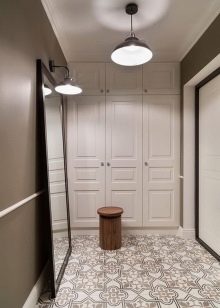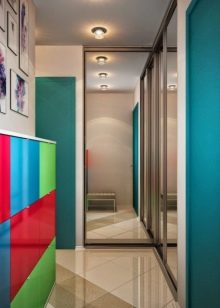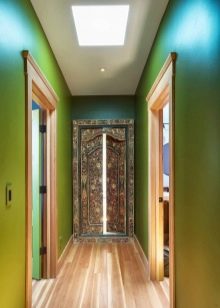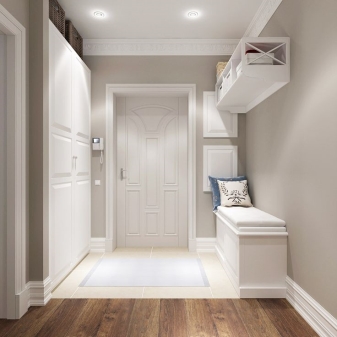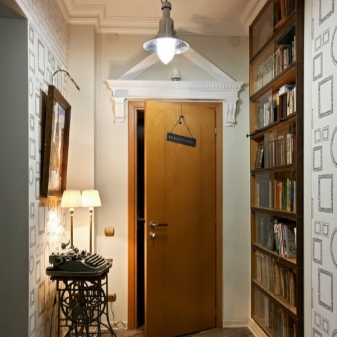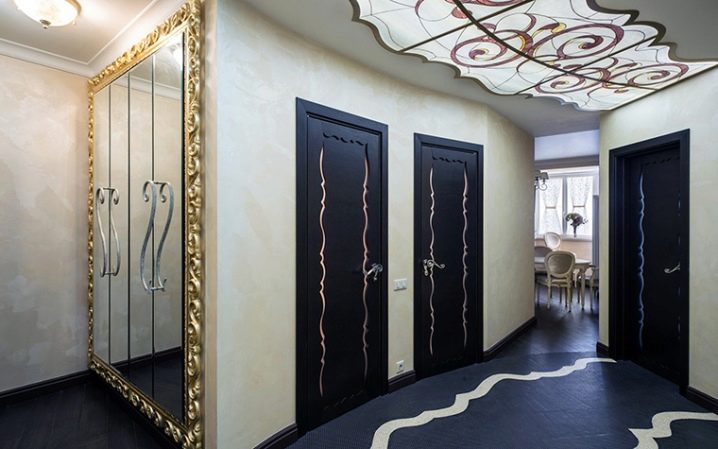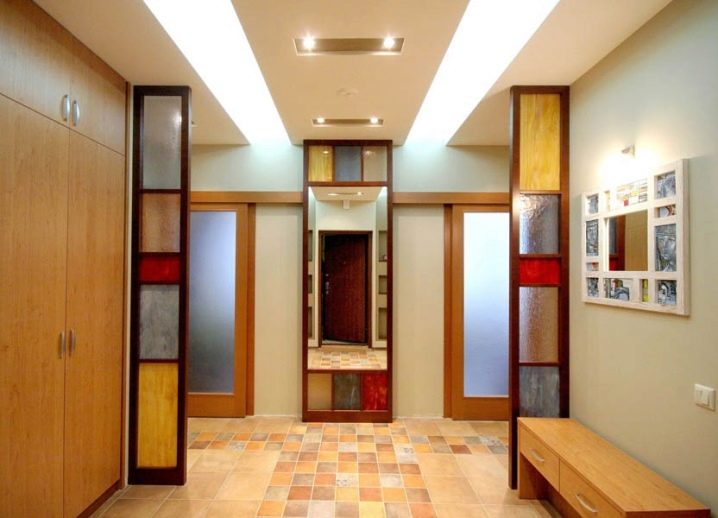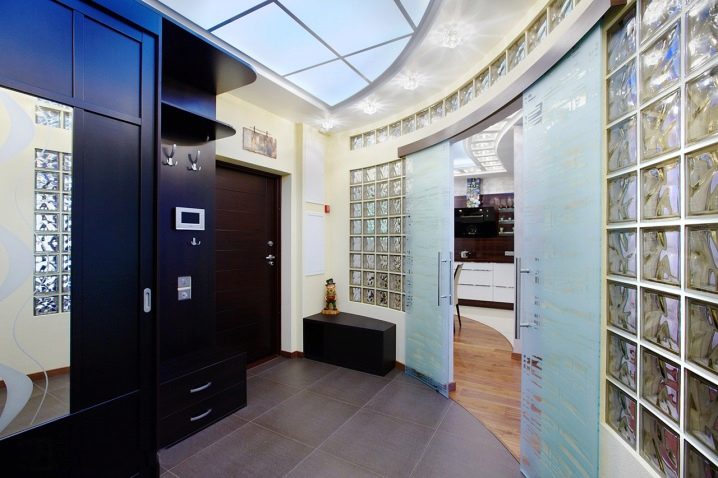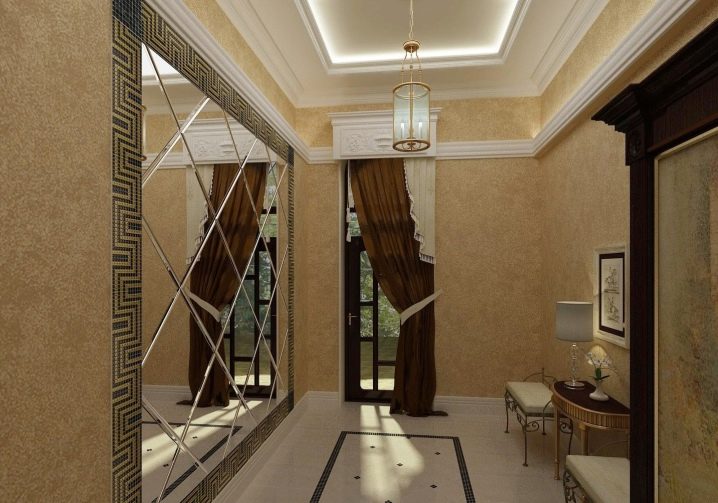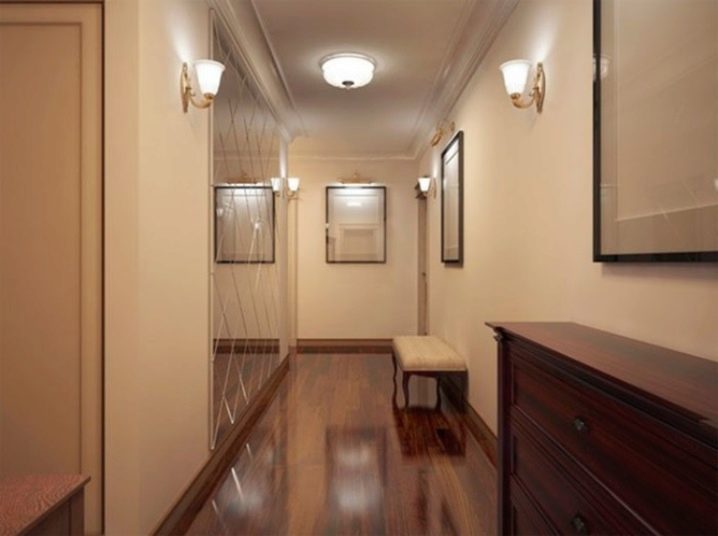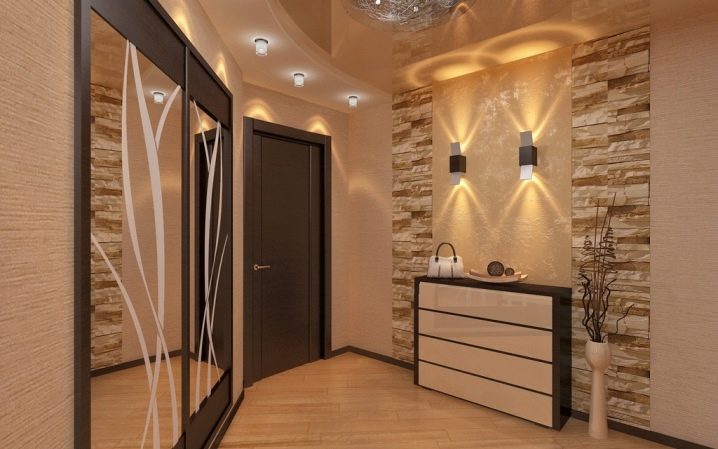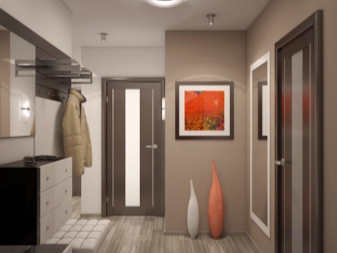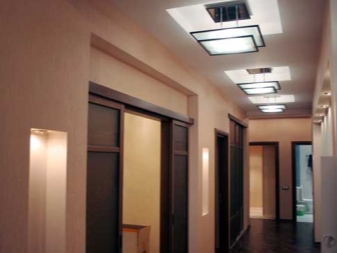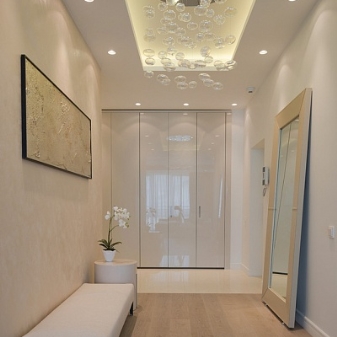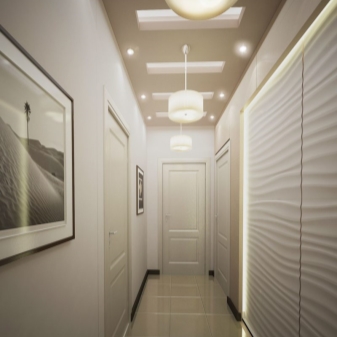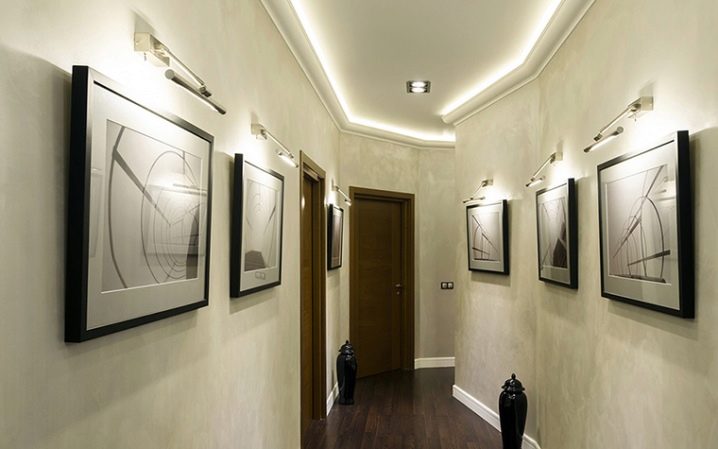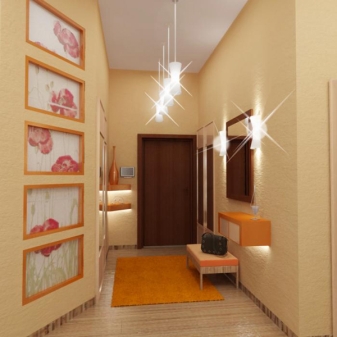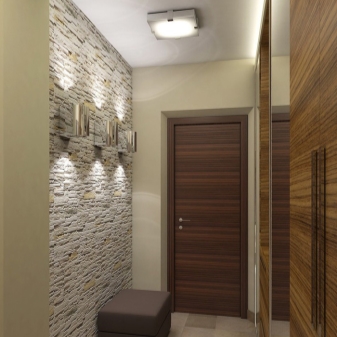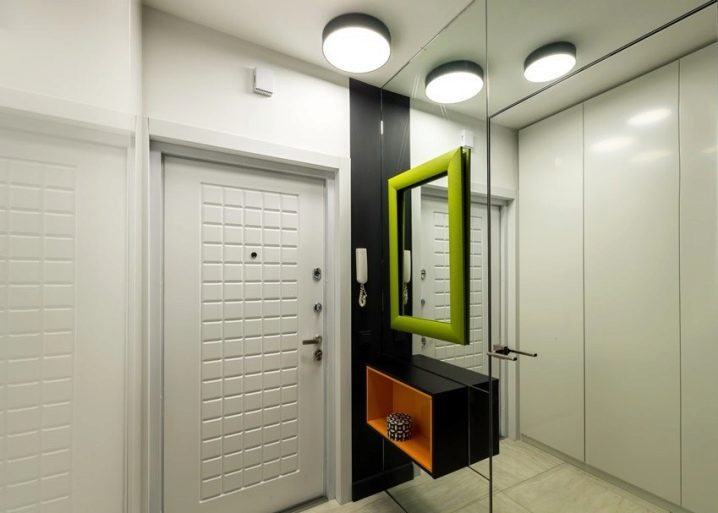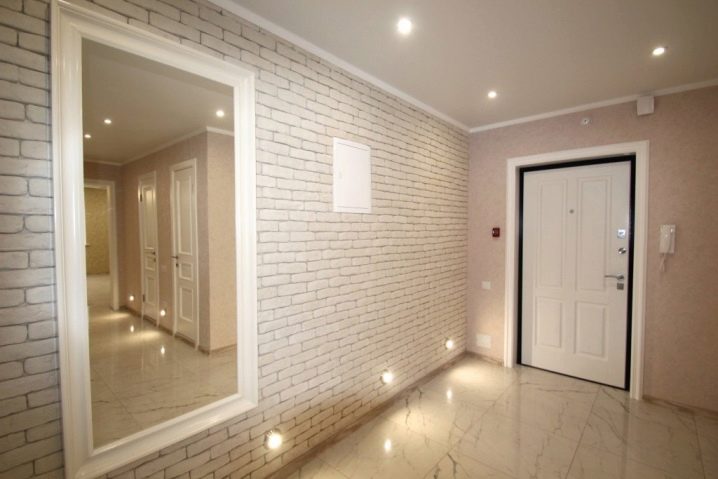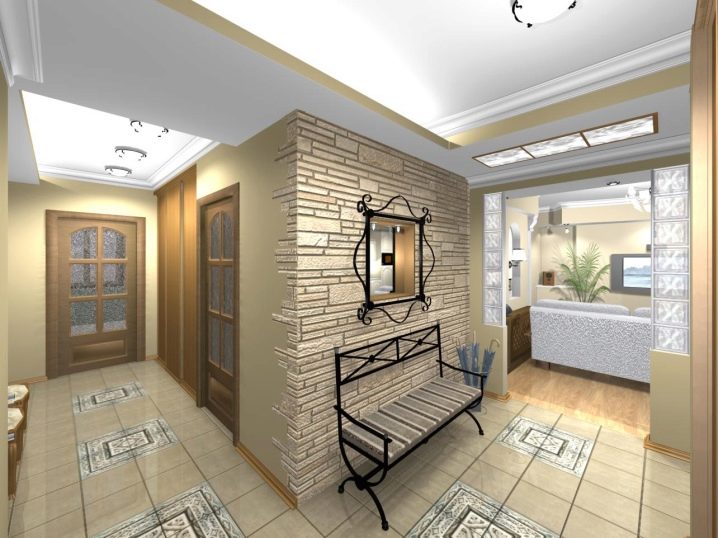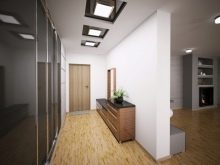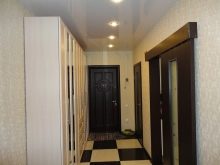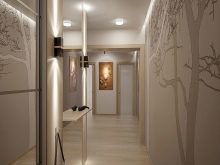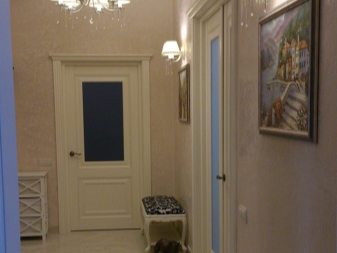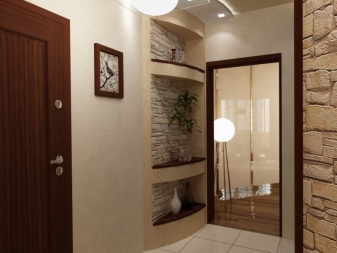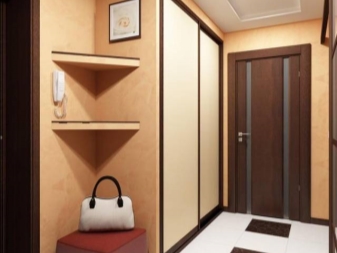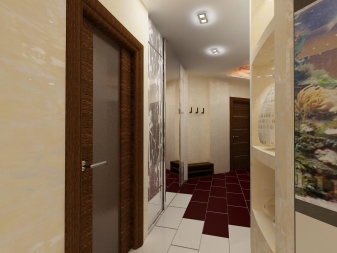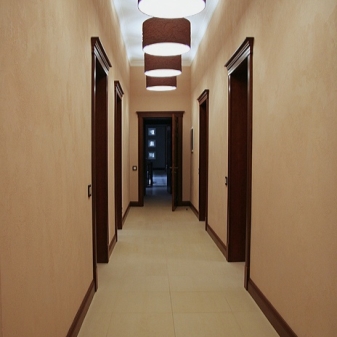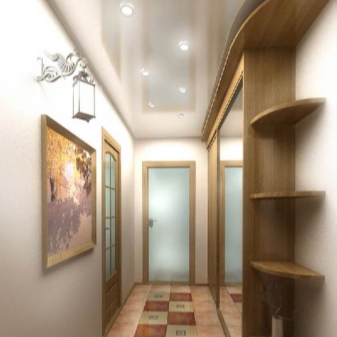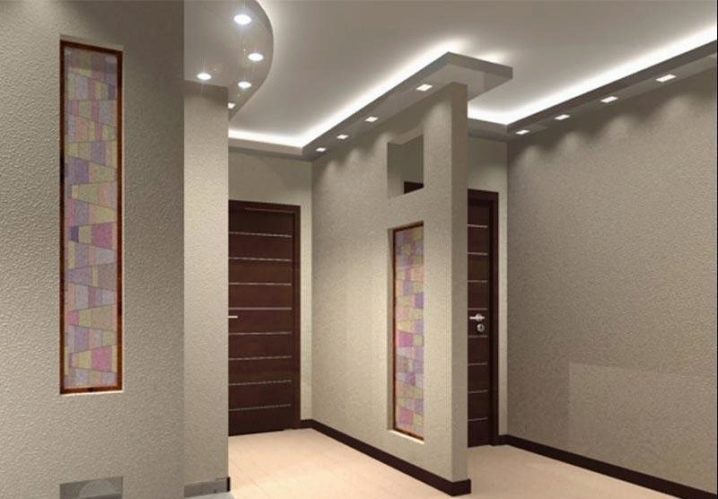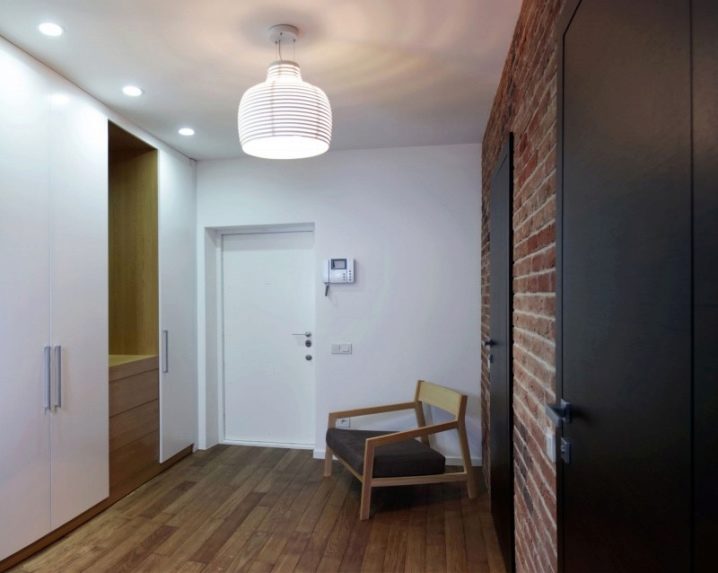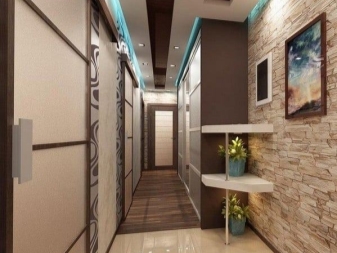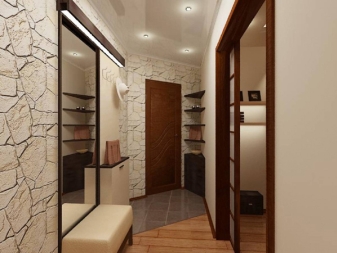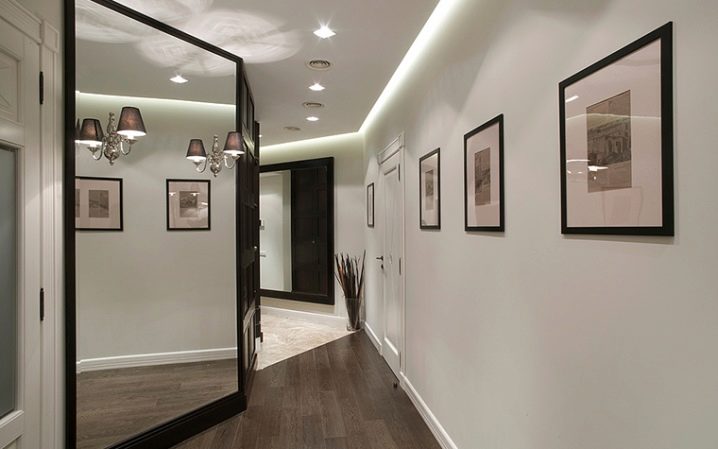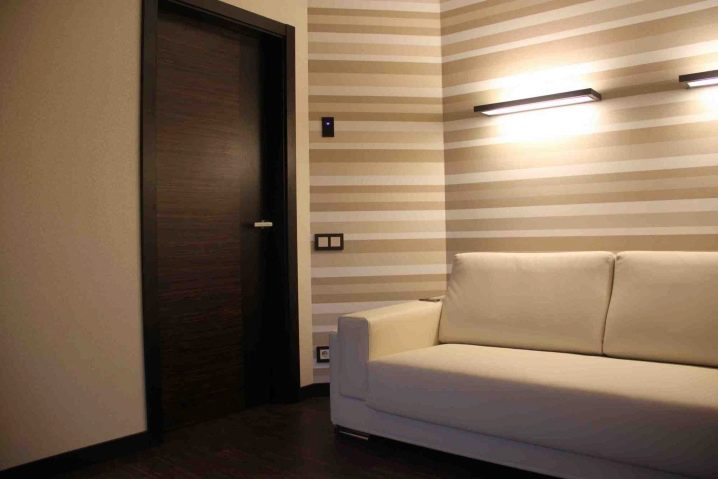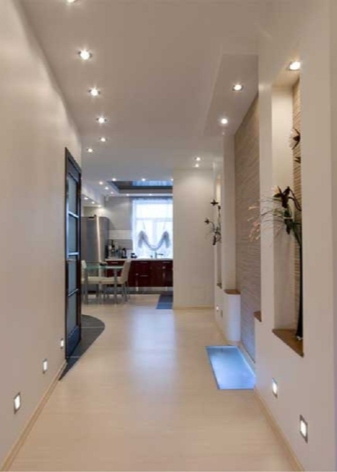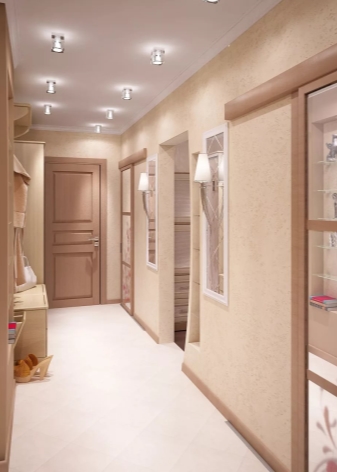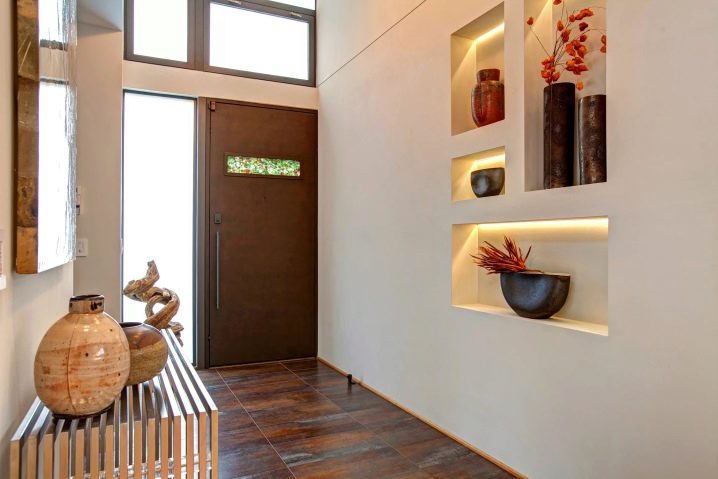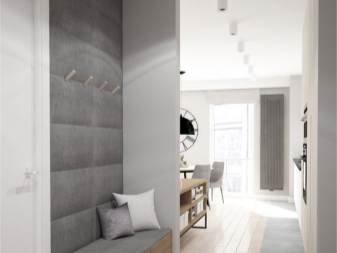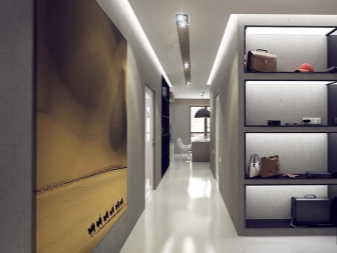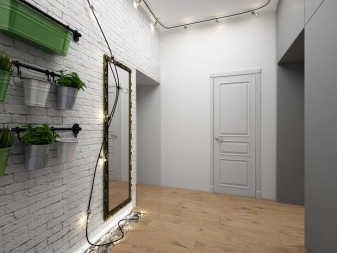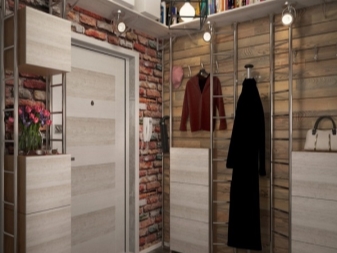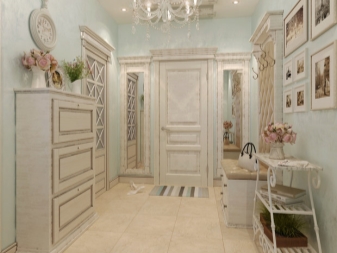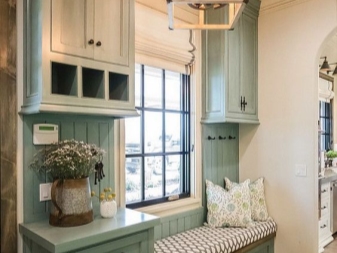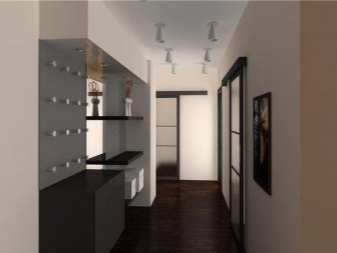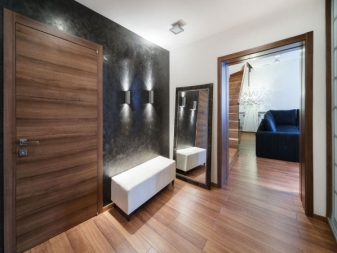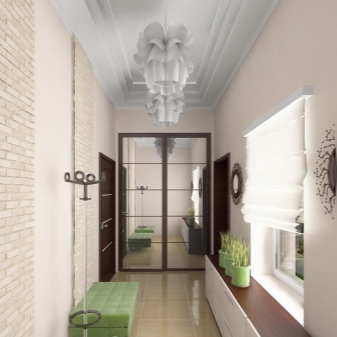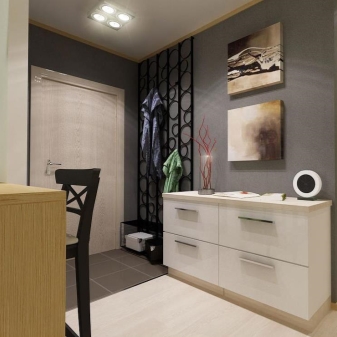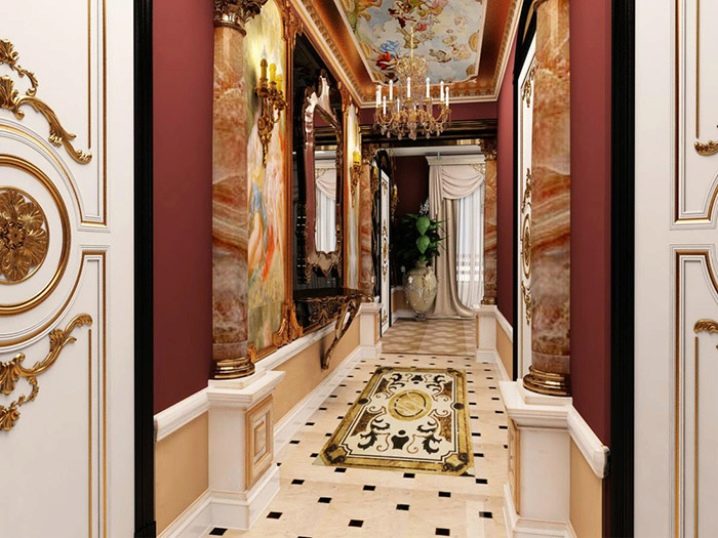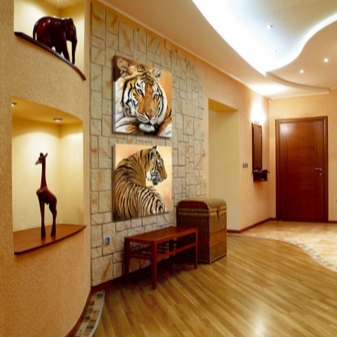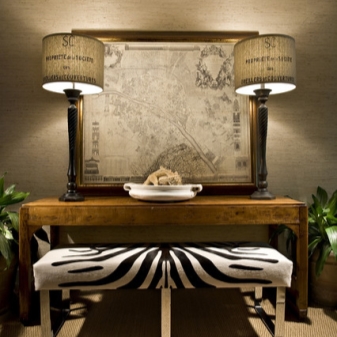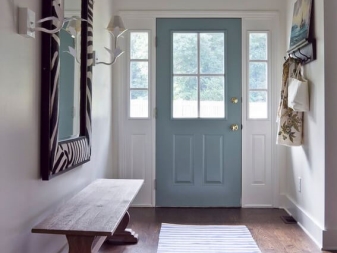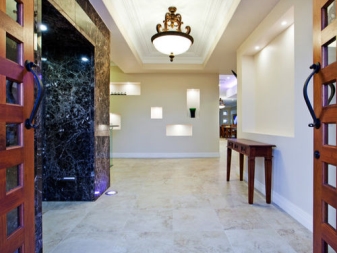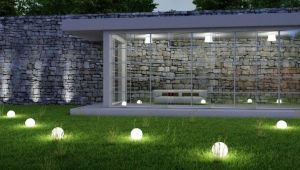Lighting in the hallway
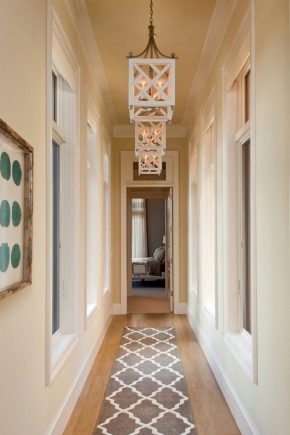
Hallway - the face of any apartment. It is very important to present this part of the house in a favorable light, and this can be done by proper lighting, combined with the interior. In stores lighting fixtures there are a huge number of models of chandeliers and lamps, suitable for the front and the corridor, but it is difficult to choose the right models among the variety of products. That is why you should get acquainted in advance with the varieties of lamps and take into account when choosing the features of your hallway.
Special features
Dark corridor does not contribute to a pleasant first impression about the apartment.Therefore, the lighting is a necessary part of the hallway. Due to the lack of windows in this part of the apartment, it is necessary to create more light using its artificial sources.
Lighting in the hallway has the following features:
- The amount of light should not be less than in adjacent rooms, regardless of the time of day. Light contrast in the transition from other parts of the apartment in the hallway is not needed, because it has a negative effect on vision.
- It is better to choose such lamps in the corridor, the power of which is maximum. It is not necessary to have lighting fixtures everywhere, because there may be little space in the corridor. Big power will allow you to save space and to light the room perfectly.
- To create additional lighting in the hallway, use partitions with glass blocks. They allow light from adjacent rooms to penetrate the corridor and create additional lighting.
- In combination with light walls and mirrors, lighting devices become the means for visual expansion of the hallway space. With proper lighting fixtures you will make the room much lighter and more spacious.To increase the space, use wall lamps, the light of which falls on certain points of the ceiling and walls.
- To expand the narrow hallway, it is necessary to direct the lighting to the upper part of the walls. Unsuccessful layout can be adjusted using different types of lighting sources, designed in the same style. If you want to visually make the ceilings lower, then direct the light with a small scattering angle to the floor and walls. To increase the height of the ceiling, it should be arranged in white color and send light to it.
- In a large hallway, you can make zonal lighting, creating an emphasis on the wardrobe or mirror surfaces. You can also combine ceiling and wall lighting.
Species
The main source of light in the hallway can be a ceiling chandelier. Depending on the characteristics of the layout, the size of the room and the style of the interior, it is round, elongated or square. In most cases, it is not much lower than the ceiling.
The corridor is not the most suitable place for bulk pendant chandeliers, so it is better to leave such models for other rooms.
In addition to the main lamp, it is permissible to embed spotlights in the ceiling. They will create an additional light effect and become a necessary detail of the interior, if the hallway is large. Such lamps can be used as the main source of light if your ceiling has low ceilings.
The accent function is performed by the LED backlight. It is installed. to emphasize any interior in the hallway or even divide the corridor into zones.
Large rooms often complement wall lights, which have a different configuration and are often not only a source of light, but also an element of decor.
Often the use of a mechanical switch in the corridor is uncomfortable, so a circuit breaker with a motion sensor has become a new word. Now, if you're late, you don't have to worry about forgetting to turn off the lights. Returning for the things left at home, you will not dirty the floors in the corridor while you go to the switch.
As a night light source, you can choose LED lamps by mounting them in the lower part of the wall or plinth.They are built in singly, at equal distance from each other. The whole LED strip is used as a floor illumination. It does not have to emit ordinary light, sometimes its glow is made in specific shades.
What to choose?
Choosing lamps in the corridor, it is important to consider its layout and features. These include factors such as ceiling height, corridor width, room layout, and ceiling coverage.
You can highlight the signs that determine the choice of specific models of lamps in the corridor.
To stretch ceilings
Stretch ceilings have long been popular, but not all models of lighting structures can be installed on them. The following lamps will be the most suitable for a similar ceiling:
- Overhead lamps - structures in which the light bulb is not flush with the ceiling, but located below. It is separated from the level of the ceiling by the platform. A small ceiling lamp is often mounted on top of the lamp, and due to this it cools rather quickly. Such models have a wide angle of light scattering.
- Another kind of bulbs - built-in. Their body, together with the light bulb itself, is built into the level of the ceiling, only the decorative ring of the body is visible from the outside. Sometimes the lamp is protected by a special glass ceiling.Several LEDs can be mounted in it to create an additional light effect. Such models are worse cooled, which may eventually affect the state of the ceiling itself.
- To create additional illumination behind the canvas stretch ceiling are installed led strip. They are not only a decorative element, but also a means of zonal distribution.
For a small hallway
A small room is best illuminated not too bulky high-power ceiling lamp, evenly surrounded by built-in lights. If there is no ceiling in the corridor for spot lighting, then pick up a pair of sconces with flat shades that do not hide space. They will look perfect if matched with a chandelier.
You can make accent lighting on any shelves and the area where the mirror is located.
In "Khrushchev"
Hallways in the "Khrushchev", whose area is just a couple of meters, also need a competent lighting design. One or two lamps can be built into the wardrobe, which is often chosen for such hallways.Ceiling lamps, the light of which is better to direct in one direction, can be located in a row. Wall lights should be directed upwards.
Reception to increase the space will be the installation of the mirror door of the closet, which will reflect the light.
In a narrow and long corridor
To expand the narrow corridor, use small, but powerful ceiling lights. They can be placed one behind the other along the entire length of the corridor, in staggered order, or form a composition on the ceiling. Supplement the corridor with wall lamps, their light will help to expand the space, especially if there are light walls in the hallway.
Make a bright diode lighting on the ceiling plinth. If the hallway has a built-in wardrobe, it can also be emphasized with additional lighting.
For a narrow corridor, give preference to daylight.
You can learn more about the rules for choosing hallway lighting from the video below.
Design and placement options
For the location of lighting in the hallway of a private house or apartment, there are many secret techniquesthat will make your apartment truly luxurious and stylish.
For a square hallway, it is better to focus on its central part with a large lamp. It can be supplemented with a decorative canopy or additional sources of lighting.
For a rectangular hallway, the built-in lights will be an interesting option for lighting design. If you have a suspended or suspended ceiling, then you are invited to a number of schemes for the location of point light bulbs.
Among them are both symmetrical and asymmetrical compositions:
- When the main light source is in the center, the spotlights can be placed one or three in each corner of the room, can be on both sides of the main source in the form of straight or curved lines.
- Spotlights can be zigzag or smooth line around the main source.
- Sometimes two types of built-in lighting devices are used in the interior design, placing them in a staggered manner or alternating with each other.
The mirror is one of the most sought-after places in the hallway for placing lamps.Wall structures create a certain zonality. They may be on the sides of the mirror. Around it can be located LED strip, which adds elegance and originality to the interior of the hallway. Mirrors in the door of the cabinet are often illuminated with built-in lights on top.
In the L-shaped corridor, as a rule, they make 2 rows of built-in lamps arranged parallel to each other. In some of these hallways made a two-level ceiling. On each level there are lamps of a certain diameter, on the central part of the ceiling they are of a larger diameter, and on the adjacent to the wall the size of point lamps is smaller.
Determine the amount
In a room without natural light, such as a corridor, you need as many additional sources of lighting as possible. But it is worth remembering that the number of lamps also depends on their power and features of the light. Fluorescent lamps are much brighter than usual, so if they are used, you can get by with fewer lighting fixtures.
With a close arrangement of small built-in ceiling lights to each other, you must buy them in larger quantities.If the lamp on the stretch ceiling is larger, then you can reduce their number in the room. Remember that busting with light can play a cruel joke. If after a dim street lighting you go into a corridor filled with bright light, then you may feel discomfort in your eyes.
Some hallways have cabinets with open shelves that can be accentuated with additional lighting. Sophisticated persons supply light with even decorative objects, such as paintings.
You can arrange the lamps in the corridor where you want. Enough to show imagination, and you get the perfect hallway with the original lighting design.
Beautiful examples in the interior
In addition to the successful arrangement of lamps in the hallway, you need to remember about their compatibility with the rest of the interior. Therefore, it is necessary to highlight the features characteristic of lighting fixtures of popular styles.
- Hi-tech style is based on geometry., it implies decorating the ceiling with LED strips. Ceiling lamps, as a rule, are built in or are at a short distance from the ceiling. They are designed in square or round shapes, emit mainly daylight and can be supplemented by wall lighting.In large corridors, fluorescent lamps are sometimes attached to the walls, which is a characteristic feature of this direction.
- Loft-style corridor with brick walls and an attic theme, it allows wall lamps with shades that imitate the design of a lantern of brown or bronze colors. For the ceiling, floodlight lighting is often selected, arranged in one or two rows along the length of the hallway. Sometimes suspended structures consisting of several miniature lamps without fanciful plafonds are permissible.
- For a gentle style provence graceful wall sconces with a light shade are preferable. They must be combined with the ceiling lamps. In some cases, in the hallway, several suspended structures are hung not very far from the ceiling. They are arranged in a row behind each other. Provence style ceiling lamps can have a square frame, be transparent or be elegant interlaced structures.
- In modern minimalism focus on the external signs of lighting devices is not put. They play an exclusively functional role in the hallway - they illuminate the space, divide the territory into zones, emphasize specific details in the interior.Minimalism presupposes ceiling-mounted luminaires or LED structures, and ceiling lamps are rarely seen. They do not differ intricate forms and often monochromatic.
- Eco style very unusual for the corridor, but even in such a room it is found. The role of lamps focuses on the lighting of the plant area. Decorative lighting for flower pots looks very original and is a hallmark of the direction of eco. If lamps with shades are chosen for the main lighting, they are made of natural materials.
- For baroque style small corridors are unacceptable, because all the pretentiousness and pomposity of style requires space. On the ceiling, a large pendant lamp made of crystal is a must-have attribute. Sometimes it can be supplemented by small LEDs on the edges of the ceiling. Wall lights can imitate candles and candelabra, their mounts are decorated in gold or bronze.
- African style entrance hall - This is a riot of colors and prints. In such a corridor, let's say a few muffled light, shading the main shades of the design - yellow, brown, green, beige.Ceiling chandeliers can be square in shape, while walls can be decorated with cone-shaped lamps, the light of which is directed exclusively upwards. An African entryway can be decorated with such lighting fixtures as a floor lamp. His lampshade will be a bright decorative element, he often takes on an accent role in the interior.
- Mediterranean style dome lamps - the perfect solution for hallway lighting. This direction involves the use of bright shades of warm shades. It does not allow the presence of daylight in the corridor. In such a room, a large number of paintings are allowed, so an additional light accent can be made on them. Simple ceiling lamps for wall lamps do not create the impression of street lighting, but rather bring a touch of coziness and romance into the interior.
Whatever interior you choose, it is important to remember that the way it appears to you and your guests depends on the lighting. If you decide to make your corridor a truly spacious and cozy place, do not forget about all the parameters for choosing lighting fixtures and try to combine in them functionality, beauty and original design.
